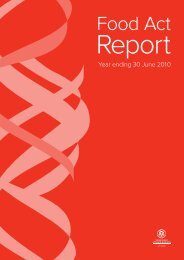Public Health and Communicable Diseases - SA Health - SA.Gov.au
Public Health and Communicable Diseases - SA Health - SA.Gov.au
Public Health and Communicable Diseases - SA Health - SA.Gov.au
You also want an ePaper? Increase the reach of your titles
YUMPU automatically turns print PDFs into web optimized ePapers that Google loves.
Figure 3: Relationship between new acquisition <strong>and</strong>infection rates to the overall burden of MR<strong>SA</strong> incontributing hospitals.Figure 5: New MRO acquisitions for all participatingcontributors, grouped by resistance category.This chart highlights the success of statewidesurveillance <strong>and</strong> quality improvement activities, sincethe overall infection rate continues to trend downwardsdespite a continuing high MR<strong>SA</strong> burden. It should benoted that both the burden <strong>and</strong> new acquisition rates aresensitive to the intensity of screening practices, whichhave increased in several hospitals over the period.*”Other” includes VRE vanA <strong>and</strong> vanB, carbapenemresistantEnterobacteriaceae or Acinetobacter species,<strong>and</strong> vancomycin intermediate Staphylococcus <strong>au</strong>reus.Figure 6: MRO acquisitions by specimen category.Figure 4: MR<strong>SA</strong> infection rates stratified by intensivecare units (ICU) <strong>and</strong> all clinical units combined.In 2005, for other MROs (excluding MR<strong>SA</strong>), urinecontinues to be the most common site of isolationfollowed by respiratory isolates (Figure 6).As Figure 4 illustrates, the rate of MR<strong>SA</strong> infectionis highest in those patients who are most at risk forinfection, i.e. intensive care unit patients.Other multi-resistant organismsDuring 2005 there were 120 new episodes of infectionor colonisation with multi-resistant organisms (MROs)other than MR<strong>SA</strong> reported. These were predominantlymulti-resistant Pseudomonas aeruginosa (MR-PAER) <strong>and</strong>extended spectrum beta-lactamase (ESBL) producingorganisms. Figures 5 <strong>and</strong> 6 present aggregate datafor the 15 contributing hospitals. The incident casesare presented rather than rates, bec<strong>au</strong>se the overallnumbers are small.ANTIMICROBIAL UTILI<strong>SA</strong>TIONThe South Australian statewide antimicrobialutilisation program was established in November2001. The program collects in-hospital antimicrobialusage data from both metropolitan <strong>and</strong> countryhospitals. Currently 14 metropolitan hospitals, 7public <strong>and</strong> 7 private, are contributing to the program,the results of which are discussed below. Data fromNovember 2001 to November 2005 are reported. Theantimicrobial utilisation rates provided are calculatedusing the number of defined daily doses (DDDs) of theantimicrobial agent/class consumed per 1000 occupiedbed days (OBDs).Monthly analysis of aggregate data suggests an upwardtrend in total antimicrobial consumption (Figure 7).38
















